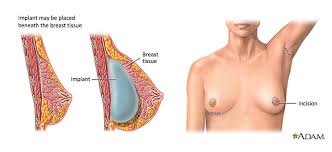Breast augmentation with implants is a surgical procedure that can alter and enhance the size and shape of the breasts. Women can undergo these elective treatments to obtain greater symmetry and balance across their physiques, create the coveted, hourglass figure or simply improve upon naturally small-sized breasts. Women can also undergo breast enlargement or reconstructive surgeries after having received single or double mastectomies as part of their cancer treatments. There are also many transgender individuals who use augmentative procedures to create realistic-looking breasts when transitioning from male to female. Rich with both benefits and drawbacks, breast enlargement can change physical appearances and lives. Following is everything you need to know about this increasingly popular cosmetic solution.
How Breast Enlargement Is Performed
 Breast enhancement typically requires the insertion of saline or silicone implants either above or beneath the chest muscles. During these procedures, surgeons can make small, u-shaped incisions just beneath the breast, where post-surgery scar tissue is less likely to be seen. Other methods involve full or partial removal of the areola, in order to insert the implant through this opening before reattaching the nipple or fashioning a new one entirely. Some of the latest and most innovative augmentation techniques involve the making of a small incision in the underarm so that implants can be placed discreetly and no discernible scar tissue exists. The method that applied is largely determined by the patient’s cosmetic goals, the amount of tissue that exists and the long-term plan for implant maintenance. In most instances, implants will need to be replaced every ten to 15 years in order to minimize the risks of leaks and ruptures.
Breast enhancement typically requires the insertion of saline or silicone implants either above or beneath the chest muscles. During these procedures, surgeons can make small, u-shaped incisions just beneath the breast, where post-surgery scar tissue is less likely to be seen. Other methods involve full or partial removal of the areola, in order to insert the implant through this opening before reattaching the nipple or fashioning a new one entirely. Some of the latest and most innovative augmentation techniques involve the making of a small incision in the underarm so that implants can be placed discreetly and no discernible scar tissue exists. The method that applied is largely determined by the patient’s cosmetic goals, the amount of tissue that exists and the long-term plan for implant maintenance. In most instances, implants will need to be replaced every ten to 15 years in order to minimize the risks of leaks and ruptures.
Tissue Expanders And Nipple Reconstruction
Women with very small breasts are often advised to make gradual changes in this area, which will allow the surrounding skin, muscles and tissues to adjust to the physical improvements that are being made. Women who have undergone full or partial mastectomies may be advised to target smaller breast sizes as well, due to a significant loss of natural tissue in the targeted area. In both instances, surgeons often use tissue expanders to ensure that the chest can eventually accommodate medium to large-sized implants. These gradually stretch the tissues, muscles and skin so that the insertion of implants is easy and relatively problem-free. Fat grafting and skin grafting procedures can be integrated into the treatment plan as well, if these measures are deemed necessary for safely creating sizable and natural-looking breasts. Tissue expanders are additionally necessary for transgender patients, even when people are using female hormones to produce non-surgical enhancements in this area.
Ladies with congenital defects affecting the nipple and and women who have undergone mastectomies may opt for nipple reconstruction as part of these treatments. This is a supplementary procedure that can be used to create breasts that maintain a wholly natural-looking shape and appearance even after the clothes have been removed. Depending upon their cosmetic goals, men who are transitioning to women may opt for nipple reconstruction also, in order to give the areola and nipple a larger and decidedly more feminine appearance.
Breast Enhancement And Breastfeeding
Even during the earliest breast augmentation procedures, it was possible to preserve a woman’s ability to breastfeed despite the addition of a silicone or saline implant. These treatments do not usually upset the arrangement and functionality of the milk ducts. Due to woman choosing this as a corrective procedure for undoing the aesthetic changes that breastfeeding is known to cause, however, it is often recommended that women wait until they are done birthing and nursing children. This way, the aesthetic improvements that this surgery is capable of producing can be long-lasting.
Implant Ruptures And Over The Muscle Concerns
There are two key concerns that women have when considering breast enlargement procedures. Foremost among these are the health effects of a ruptured implant. Historically, silicone implants were deemed unsafe, due to the body’s inability to tolerate or process this toxic material once it was released.
See Risks of Breast Implants by US FDA
In modern times, saline implants have been considered the safer alternative, given that the saline solution emitted from ruptured implants can be easily recognized and processed by the body. The significantly more natural look and feel of saline implants, however, make them the preferred option in many instances. Moreover, innovations in saline implant designs have helped to mitigate many of the former risks.
The second concern is whether or not the implants should be placed over or under the muscle. Over the muscle implants are safer and easier than under the muscle implantation, however, there is always the risk of being able to see the creases and folds of the implants just beneath the skin, particularly when the patient is bending over. Under the muscle implants pose a greater risk of implant rupture, but they also produce smoother and more seamless-looking results. Surgeons can share both pros and cons for each choice, however, it is important for people to always choose implant types and implantation methods that are best in line with their own needs and cosmetic goals.